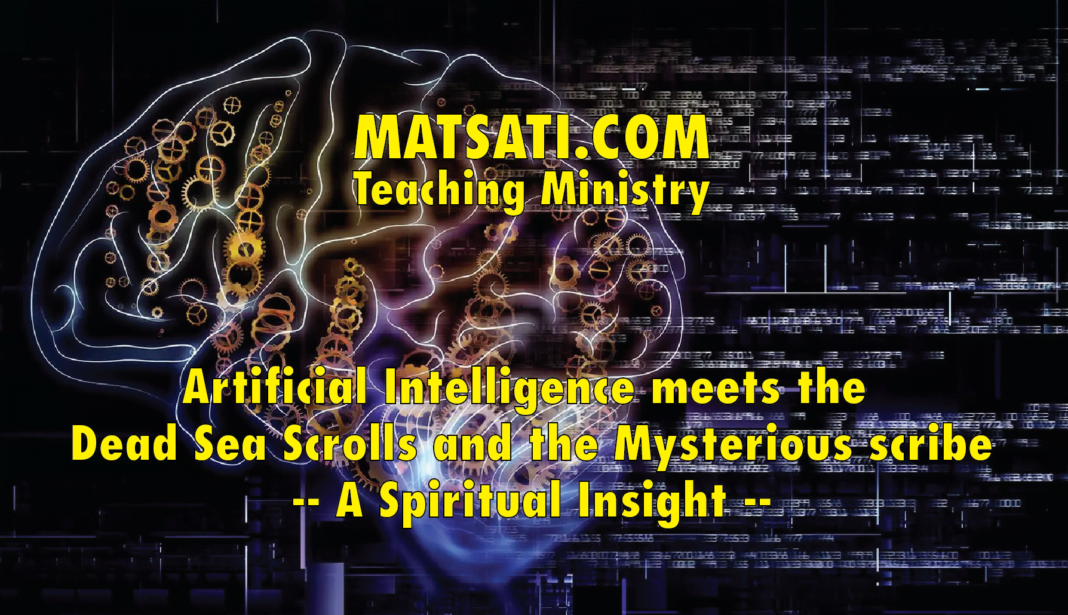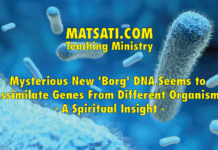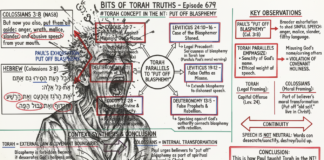The dead sea scrolls are a collection of 25,000 fragments of ancient Jewish Hebrew religious manuscripts that are found in the Qumran Caves in the Judaean Desert near Ein Feshkha on the northern shore of the Dead Sea in the West Bank. The manuscripts that were discovered span from the 4th century BCE to the 2nd century CE. The Dead Sea Scrolls are famous for containing the oldest manuscripts of the Hebrew Bible including both the biblical passages and sectarian documents. Most of the texts are in Hebrew, there are some that are written in Aramaic, and there are a few which are written in Greek. New discoveries from the Judaean Desert add Latin from Masada and Arabic from Khirbet al-Mird texts. The texts are written on various materials, parchment, papyrus, and there is one that was written on copper. Over the last several years, with the use of artificial intelligence (AI), scholars are trying to identify the number of scribes who copied the scrolls and have recently published a paper on this effort. [1]
References
- Popović M, Dhali MA, Schomaker L, “Artificial intelligence based writer identification generates new evidence for the unknown scribes of the Dead Sea Scrolls exemplified by the Great Isaiah Scroll (1QIsaa).” (2021) PLOS ONE 16(4): e0249769. https://doi.org/10.1371/journal.pone.0249769
The primary focus of this work was to identify individual scribes by the way in which the Hebrew letters are formed, their shapes, which are unique to each individual person. Each document that is under investigation was scanned digitally, an AI algorithm was designed to process the digital images and extract each letter comparing the letters shape to other letters. This analysis was conducted on 51 manuscripts that visually appear to share a particular handwriting style. The style of Hebrew is called “semi-formal.” Joseph Naveh in his paper “A Palaeographic Note on the Distribution of the Hebrew Script” (The Harvard Theological Review, Vol. 61, No. 1 (Jan., 1968), pp. 68-74, Published By: Cambridge University Press) writes that “a society can be considered literate if, additional to professional scribes, there are people who can write, not only of a higher social class, but also among the lower to middle classes. Such a situation is evident by three cursive sub-styles, an extreme free cursive, a formal or chancellery cursive, and a vulgar cursive. The extreme cursive is that of the educated persons. Formal cursive is the conservative handwriting of the scribe who was expected to write clearly and conventionally. The vulgar cursive is the handwriting of a person who learned the formal script, like the educated person, but was not skilled enough for independent development.” The vulgar semi formal script occurs on pottery and jars, which deals mainly with the individual characters which are the focus point of this paper. [1]
Previously a paleographer Ada Yardeni grouped 90 Dead Sea Scrolls fragments together manually, her argument was based upon the letter Lamed saying that this one letter enabled this grouping due to identifying a specific way in which the lamed was written. Researchers had not been able to validate this argument until the advent of AI technology which is capable of doing this on a larger scale. Some of the fragments that she had identified were not testable as these fragments were too small to make a proper comparison. When running the AI software analysis algorithm on these manuscripts, there were 51 manuscripts which showed a statistically significant correlation.
The researchers said that there were some very significant findings, that the manuscripts were quite diverse, and seven manuscripts, including one Aramaic on from the sectarian manuscripts, and non-sectarian manuscripts, as well as para-biblical texts, including one known as Naftali, with writings about Rachel and Joseph was attributed to one author. Among the documents this person authored was the Miqsat Ma’ase ha-Torah (MMT) scroll, considered by scholars to be a foundational document of the Jewish sect that many scholars believed lived in Qumran.
This same person wrote texts on various topics which is hoped would shed new light on the identity of the community and their relationship with the rest of Judaism. The Dead Sea Sect (also called Qumran Sect or Qumran Community), the name refers strictly to a Jewish community which lived in the Second Temple period and which adopted a strict and separatist way of life. The Jewish virtual library states the following:
“It is widely held that the wider parent movement, as well as the yaḥad, should be identified with the Essenes described by Josephus (War I. 78–80; 2,119–161), Philo (Quod omnis probus, 75–91) and the elder Pliny (Natural History 5.17, 4). While Pliny locates Essenes specifically near the Dead Sea, according to Josephus and Philo they lived throughout Judea. On the manner of initiation, attitudes to women and to the Temple there are strong similarities between Essenes and the larger sectarian movement, but opinion on the identification is not unanimous. In the light of a few halakhic parallels with details preserved in the Talmud, it has recently been suggested that the sect may have been related to the Sadducees. The identification with Zealots , once proposed, is now largely rejected, though the sect probably sympathized with Jews who fought against Rome and may have joined them.” (https://www.jewishvirtuallibrary.org/the-dead-sea-sect, Access date 5/6/2021)
An AI algorithm was used to recognize background and foreground and to measure the movement of the writing and calligraphy. This enabled the researchers to validate whether manuscripts were actually written by the same person or by different people. For example, the fact that these were written using a similar calligraphic style provides insights into the training that was received for this group of people. Apart from eight manuscripts being penned by the same person, the rest were penned by different people. This study is ongoing, and may include refinements to the AI algorithm which is used for more concise conclusions.
The Spiritual Insights that we receive from this type of research is related to the holiness and importance of God’s Word and how men throughout history have recognized this and some have even devoted their lives to the preservation and meticulous copying of the Word of God so that it could be transmitted מדור לדור (from generation to generation). The significance of having God’s word is so great, that men have even given their lives unto death to preserve and preach the Words of life to peoples and nations. These things function as a testimony of the power of God and His truth in theirs and our lives. These things are also revealed to us in the first few passages out of the Torah which state the following:
ספר בראשית פרק א
א בְּרֵאשִׁית בָּרָא אֱלֹהִים אֵת הַשָּׁמַיִם וְאֵת הָאָרֶץ: ב וְהָאָרֶץ הָיְתָה תֹהוּ וָבֹהוּ וְחשֶׁךְ עַל-פְּנֵי תְהוֹם וְרוּחַ אֱלֹהִים מְרַחֶפֶת עַל-פְּנֵי הַמָּיִם: ג וַיֹּאמֶר אֱלֹהִים יְהִי-אוֹר וַיְהִי-אוֹר: ד וַיַּרְא אֱלֹהִים אֶת-הָאוֹר כִּי-טוֹב וַיַּבְדֵּל אֱלֹהִים בֵּין הָאוֹר וּבֵין הַחֹשֶׁךְ: ה וַיִּקְרָא אֱלֹהִים | לָאוֹר יוֹם וְלַחֹשֶׁךְ קָרָא לָיְלָה וַיְהִי-עֶרֶב וַיְהִי-בֹקֶר יוֹם אֶחָד:
Bereshit / Genesis 1:1-5
1:1 In the beginning God created the heavens and the earth. 1:2 The earth was formless and void, and darkness was over the surface of the deep, and the Spirit of God was moving over the surface of the waters. 1:3 Then God said, ‘Let there be light’; and there was light. 1:4 God saw that the light was good; and God separated the light from the darkness. 1:5 God called the light day, and the darkness He called night. And there was evening and there was morning, one day. (NASB)
Here the Torah records the very first act of creation that God had accomplished as he said יְהִי-אוֹר “Let there be light.” The very next thing the Torah tells us is וַיַּרְא אֱלֹהִים אֶת-הָאוֹר כִּי-טוֹב וַיַּבְדֵּל אֱלֹהִים בֵּין הָאוֹר וּבֵין הַחֹשֶׁךְ “God saw that the light was good; and God separated the light from the darkness.” Here we see God separating (וַיַּבְדֵּל) light from darkness. This has great spiritual significance as the light of God represents righteousness, and darkness represents the lie and what is evil. Notice how the very first thing God does is making a separation or distinction between light and darkness which is foundational to the concept of kedushah (קְדֵשָׁה, holiness). This concept of holiness is expressed in the difference between light and darkness, between good and bad, and between the sacred and the profane (or ordinary). This is why we read according to Bereshit / Genesis 2:7 the following: ג וַיְבָרֶךְ אֱלֹהִים אֶת-יוֹם הַשְּׁבִיעִי וַיְקַדֵּשׁ אֹתוֹ כִּי בוֹ שָׁבַת מִכָּל-מְלַאכְתּוֹ אֲשֶׁר-בָּרָא אֱלֹהִים לַעֲשֹוֹת: 2:3 Then God blessed the seventh day and sanctified it, because in it He rested from all His work which God had created and made. (NASB) Here we are told the Lord וַיְבָרֶךְ אֱלֹהִים אֶת-יוֹם הַשְּׁבִיעִי וַיְקַדֵּשׁ אֹתוֹ He blessed the seventh day and sanctified (וַיְקַדֵּשׁ) it. This process of separation, of sanctification, of making holy is how we understand God’s Word functions in our lives from the very first few verses in the Torah, to the very last verses in the book of Revelation. There is an overall theme of kedushah in our lives as God’s people which is drawn out in all of Scripture. For example, in the book of Vayikra / Leviticus, holiness is a primary theme. We note that in Vayikra / Leviticus the root word kadosh (קדש) occurs 150 times in that book alone. This book speaks to us on the imperative to be holy, to be conscious of what is sacred and what is profane, righteousness verses evil, good verses bad, and what is clean and unclean. These things are related to sin and righteousness in our lives, as God calls us to perform Teshuvah (Repententance) and to walk in His ways by walking in the footsteps of the Messiah. We note how Vayikra / Leviticus states this explicitly saying י וּלְהַבְדִּיל בֵּין הַקֹּדֶשׁ וּבֵין הַחֹל וּבֵין הַטָּמֵא וּבֵין הַטָּהוֹר: “you are to distinguish / separate between the holy and between the common, between unclean and between clean.” The root word we find in the beginning of the Torah is repeated here וּלְהַבְדִּיל as separating the light form darkness. We are to make a division in our lives as discerning between sin and righteousness. This is how the Torah speaks to us saying, כו וִהְיִיתֶם לִי קְדשִׁים כִּי קָדוֹשׁ אֲנִי יְהוָֹה וָאַבְדִּל אֶתְכֶם מִן-הָעַמִּים לִהְיוֹת לִי: “You shall be holy to me, for I the Lord and holy and I have separated (וָאַבְדִּל) you from other people that you should be mine.” (Vayikra / Leviticus 20:26) We note what Peter writes in 1 Peter 1:16 For the Scriptures say, “You shall be holy, because I am holy.” (KJV) This is how we are made precious in God’s sight, by washing us in His Holy Word. (Consider this too, we should not behave as swine who after a bath go and wallow in the mire again.) The reason being, the true nature of the Word of God is found in its authority in our lives as a rule of conduction, as ordering our lives for the glory of God. We note what Yeshua did on our behalf, sanctifying us in heaven. This is why God is looking for people who are consecrated or set apart for His use. And He knows who those holy ones should be because He chose us (Ephesians 1:4) and called us to be holy for His purpose (2 Timothy 1:9). There are six ways to be holy unto the Lord, (i) Honor God, (ii) show love, (iii) honor parents, (iv) serve others, (v) abstain from sin, and (vi) modify our conduct. As those who love the Lord will walk in His ways (this honors Him) doing these things, and the one who desires to live holy will reflect that desire in their conduct everywhere and at all times. (2 Peter 3:11)
This is what the Scientific research draws out for us, as the men of the generation of Qumran devoted their lives to holiness and the sacred work of preserving God’s Word. Holiness first and foremost involves the awareness of what is pure and righteous as compared to what is of the material world, profane, and unholy (common). The very fact of God separating the light from darkness which is centered upon men, women, and children, and the willingness to live for and serve the Lord, where without God’s help this is impossible to be entirely perfect all of the time. This is the primary focus of the NT text as directing us to recognize our earthly condition and what is required in heaven before a holy God (i.e. this perspective also instructs us on why we need Yeshua in rder to be sanctified before our Father in heaven in the heavenly Tabernacle). The point of these things is that God does not want us to merely acknowledge His holiness, or that He did these things according to the Scriptures. The Lord calls us also to be holy, because of what the Messiah has done for us in the heavenly Tabernacle, and how we are in a relationship with Him, and this implies that we are to exercise personal holiness, and separation from this world unto God. This does not mean that we are to withdraw from the world, but that we do not take upon ourselves the ways of the world in lies, sinful living, immoral thoughts and actions, and the ideologies of demons (ie. critical theory, liberalism, LGBTQ, etc). This is how God called us, כו וִהְיִיתֶם לִי קְדשִׁים כִּי קָדוֹשׁ אֲנִי יְהוָֹה וָאַבְדִּל אֶתְכֶם מִן-הָעַמִּים לִהְיוֹת לִי: “You shall be holy to me, for I the Lord and holy and I have separated (וָאַבְדִּל) you from other people that you should be mine.” (Vayikra / Leviticus 20:26) In the book of Vayikra / Leviticus we find the various commands on the sacrificial system, the purpose of the sacrificial system was to draw near to God and this drawing near required separation from the profane world and its unclean ways. The call to be holy is the call to wake up and become alive to God and His Word in the midst of this world.
In the descriptions of God separating (וַיַּבְדֵּל) light from darkness, we find this process throughout all of Scripture, for example, let’s look at the Pesach (Passover) and deliverance of Israel from bondage in Egypt. According to the Torah, from the book of Vayikra / Leviticus we read, מה כִּי | אֲנִי יְהֹוָה הַמַּעֲלֶה אֶתְכֶם מֵאֶרֶץ מִצְרַיִם לִהְיֹת לָכֶם לֵאלֹהִים וִהְיִיתֶם קְדֹשִׁים כִּי קָדוֹשׁ אָנִי: “for I the Lord who brought you up from the land of Egypt to be your God. You shall be holy, for I am holy.” (Vayikra / Leviticus 11:45) This is how we are called to live in the Messiah Yeshua as being redeemed, we are made holy by God, and consequently, Peter writes 1:15 but like the Holy One who called you, be holy yourselves also in all your behavior; 1:16 because it is written, ‘You shall be holy, for I am holy.’ (NASB, 1 Peter 1:15-16) We note here this is about wrapping ourselves in God’s commands, just as we read according to the book of Revelation 19:1-9:
Revelation 19:1-9
19:1 After these things I heard something like a loud voice of a great multitude in heaven, aying, ‘Hallelujah! Salvation and glory and power belong to our God; 19:2 because His judgments are true and righteous; for He has judged the great harlot who was corrupting the earth with her immorality, and He has avenged the blood of His bond-servants on her.’ 19:3 And a second time they said, ‘Hallelujah! Her smoke rises up forever and ever.’ 19:4 And the twenty-four elders and the four living creatures fell down and worshiped God who sits on the throne saying, ‘Amen. Hallelujah!’ 19:5 And a voice came from the throne, saying, ‘Give praise to our God, all you His bond-servants, you who fear Him, the small and the great.’ 19:6 Then I heard something like the voice of a great multitude and like the sound of many waters and like the sound of mighty peals of thunder, saying, ‘Hallelujah! For the Lord our God, the Almighty, reigns. 19:7 ‘Let us rejoice and be glad and give the glory to Him, for the marriage of the Lamb has come and His bride has made herself ready.’ 19:8 It was given to her to clothe herself in fine linen, bright and clean; for the fine linen is the righteous acts of the saints. 19:9 Then he said to me, ‘Write, ‘Blessed are those who are invited to the marriage supper of the Lamb.’‘ And he said to me, ‘These are true words of God.’ (NASB)
We note how Revelation 19:8 writes what was given for to be clothed in fine linen, these were the righteous acts of the saints. These are the commands of God, the Torah. A few additional verses which speak to this are found in Isaiah 61:10 and Tehillim / Psalms 132:9.
Isaiah 61:10
I will greatly rejoice in the Lord; my soul shall exult in my God, for he has clothed me with the garments of salvation; he has covered me with the robe of righteousness, as a bridegroom decks himself like a priest with a beautiful headdress, and as a bride adorns herself with her jewels. (י שֹוֹשֹ אָשִֹישֹ בַּיהֹוָה תָּגֵל נַפְשִׁי בֵּאלֹהַי כִּי הִלְבִּישַׁנִי בִּגְדֵי-יֶשַׁע מְעִיל צְדָקָה יְעָטָנִי כֶּחָתָן יְכַהֵן פְּאֵר וְכַכַּלָּה תַּעְדֶּה כֵלֶיהָ:)
Tehillim / Psalm 132:9
Let your priests be clothed with righteousness, and let your saints shout for joy. (ט כֹּהֲנֶיךָ יִלְבְּשׁוּ-צֶדֶק וַחֲסִידֶיךָ יְרַנֵּנוּ:)
We note here how Isaiah states שֹוֹשֹ אָשִֹישֹ בַּיהֹוָה תָּגֵל נַפְשִׁי בֵּאלֹהַי how he rejoices in the Lord his God. This rejoicing is because כִּי הִלְבִּישַׁנִי בִּגְדֵי-יֶשַׁע מְעִיל צְדָקָה the Lord God cloths him in salvation and righteousness. The Psalms states, כֹּהֲנֶיךָ יִלְבְּשׁוּ-צֶדֶק וַחֲסִידֶיךָ יְרַנֵּנוּ the priests are clothed in righteousness, and the חֲסִידֶיךָ “Your grace one’s” will shout for joy, note the grace one’s is translated as saints. Note the word khesed (חסד) for grace is used here in the Psalms as referring to God’s people, those who have been called to walk in His ways! The preservation of God’s word from antiquity demonstrates the holiness and sacredness of God’s word. Here in both Isaiah 61:10 and Tehillim / Psalms 132:9 speak of righteousness as being a form of clothing similar to Revelation 19:8. Acts of righteousness is the outworking of one’s faith which is visible to the human eye for all to see. This is the idea of the inward faith and the visible faith. Paul wrote in Ephesians 2:8 For by grace are ye saved through faith; and that not of yourselves: it is the gift of God. (KJV) the idea here is that grace works towards righteousness (salvation) for sinners, and that same grace should work for God’s people towards righteous work. Note how there is a difference between what has been done in heaven as compared to what we are called to live here on earth. This means our inward faith should cause us to be focused more on good works because this is our act of faith. Other examples may be taken from the text that speaks of the Crown of Life. The Crown of life is for perseverance through suffering (James 1:12 and Revelation 2:10); the Crown of Righteousness is for living in expectant hope of the return of Yeshua (2 Timothy 4:8); and the Crown of Glory is for the selfless exercise of ones spiritual gift (1 Corinthians 9:17 and 1 Peter 5:2-4). Along with the white raiment worn in heaven, each crown appears to be the outward manifestation reflecting what was on the inside. Note also how these things are the result of God dwelling in our midst, the dwelling of the Spirit of God in our lives. This is what the scientific research draws out for us on the sacredness and Holiness of God’s word and its importance in our lives. The word of God was meant to be lived out, to be taken by faith from the inside to the outside is what Paul was saying in Romans 1:17 “For in it the righteousness of God is revealed from faith to faith; as it is written: ‘But the righteous one will live by faith.'” Thus those who belong to the Lord will live righteously before God and men, this is the meaning of “faith to faith” and living by that faith, the visible fruits of the Spirit which will appear as white raiment and crowns in heaven.









